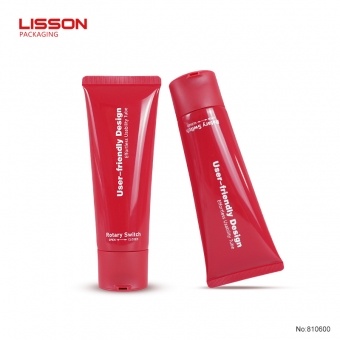
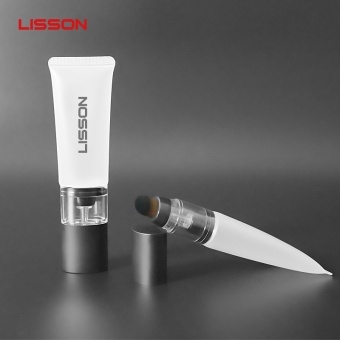
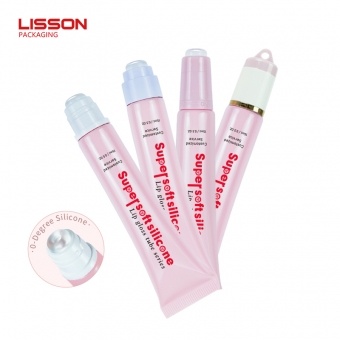
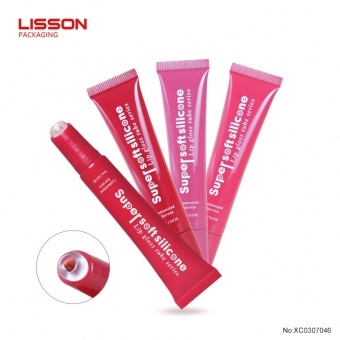

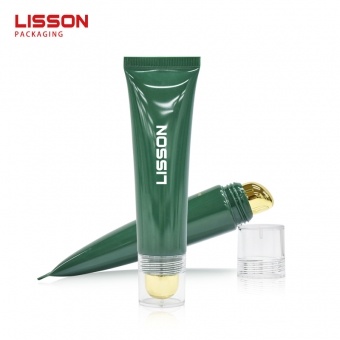
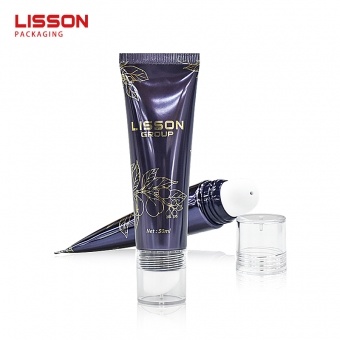

There are many types of tubes with different material properties, so the processing methods of various hoses are also different. The printing method of tubes is closely related to the hose manufacturing process and can be divided into two categories: one is forming first and then printing, which is mainly used for extruded plastic tubes, and the printing methods are mainly letterpress offset printing and screen printing. The other is printing first and then forming, which is mainly used for all-plastic composite hoses and aluminum-plastic composite tubes, using flexographic printing and gravure printing.
After the tubes are formed, the printing method can be letterpress offset printing or screen printing. At present, letterpress offset printing occupies a major position, and screen printing has become an indispensable supplementary printing method for letterpress offset printing with its distinctive characteristics.
(1) Letterpress offset printing
In tube printing, letterpress offset printing technology combines the characteristics of letterpress and offset printing, and has good printing effect. Some people vividly call it "dry offset printing" (Dry Offset), and it is called "Letter Set" abroad. When printing in single color, the maximum number of screen lines can reach 1751pi; when printing in multiple colors, the number of screen lines can reach 100~110lpi. At present, eight-color printing presses have appeared in the field of hose offset printing in the world, meeting the specific requirements of some customers.
Hose letterpress offset printing process does not use water rollers. It uses slurry ink with higher viscosity. The ink fountain roller transfers the ink from the ink fountain to a group of rubber rollers. Through the stringing roller, the ink is evenly distributed on the inking roller, and the inking roller transfers the ink to the relief of the plate cylinder. The raised image part is about 0.50mm higher than the blank part. Then the ink on the plate is transferred to the rubber cloth of the rubber cylinder, and then transferred to the surface of the composite tube.
The printing plate of letterpress offset printing consists of a base and a photosensitive polymer layer. The base is generally metal or photosensitive polymer resin. The printing plate with a metal base has a slightly higher printability. Even if it is a resin base printing plate, the printability can reach 150,000~200,000 tubes. At present, four-color hose printing machines are generally used for hose printing, and their basic structure is shown in Figure 6-12.
Figure 6-12 Four-color tubes printing machine
The machine consists of a four-color plate cylinder, a four-color inking device and a rubber cylinder.
When printing, the hose is inserted into the mandrel of the turntable, and the hose can rotate on the mandrel. When the turntable rotates, the rubber cloth on the rubber cylinder contacts the surface of the hose to apply printing pressure, and the images on the printing plate can be transferred in sequence by the rubber cloth to complete multi-color printing. After printing, the hose is pulled out of the mandrel and sent to the drying device for drying.
Reasonable printing pressure can be obtained by adjusting the center distance between the turntable and the rubber cylinder or changing the pad thickness of the rubber cloth. In addition, the mandrel should meet certain precision requirements, and the mandrel and the inner diameter of the hose are interchangeable.
The printing plate used is generally made of zinc plate and aluminum plate as the plate material, and the relief plate is made by phototypesetting, and resin relief plate can also be used.
If the hose printing machine adopts an automatic conveying system, the printing speed can reach 150 pieces/minute. If it is connected with an automatic cartoning machine, the hose production can be automated from the supply of materials to the delivery of finished products to meet the needs of mass production.
On the tube automatic production line composed of a printing machine, an extruder, a nozzle machine and a film capping machine, hose molding and printing can be completed at one time, and the production speed can reach 100 pieces/minute. In addition, hose printing machines are generally equipped with a glazing unit, which uses UV ink and UV varnish to achieve high-speed production of printing and glazing.
The production line can also be equipped with an automatic detection device, in which the camera device stores the image information of the standard product, and then scans the printed image of each hose, compares it with the stored standard information, and automatically makes a judgment on whether the product is qualified, and rejects unqualified products, ensuring that the hose printing quality is within a stable range. Compared with screen printing, letterpress offset printing has a relatively low printing cost and is widely used.
(2) Screen printing
The unique screen can be applied to various inks, and can achieve a variety of special effects of color hose printing, such as pearlescent and metallic ink printing. The thick ink layer of screen printing can effectively cover the color gloss of the tubes itself, especially the dark-colored tube shows a strong color effect after printing.
The surface of some hose products is made of modified PE material, which has a soft touch. After screen printing, it can meet the requirements of wear resistance without polishing. Screen printing has a fast plate making speed and a short equipment debugging time. It can print qualified products in a short time, which meets the needs of multi-batch and small-batch hose printing business. For some hoses with frequently changed design patterns, screen printing is the most suitable.
The development of screen printing technology has made the tube screen printing machine develop towards full automation. From the front-end feeding device to the UV screen printing unit, and then to the hose packaging directly after printing, fully automatic printing production can be achieved.
 online service
online service +86-20-86889886
+86-20-86889886 lissontube@gzlisson.com
lissontube@gzlisson.com +8615099958531
+8615099958531